Everyone loves to go on vacation, but what happens to your betta fish while you’re away?
Betta fish vacation care is a major concern for many owners, and worrying about your pet can ruin your enjoyment of your long-anticipated break. So, how long can bettas go without food? And what’s the best betta fish food for vacation?
Read this guide to find out more about how to feed and care for your betta buddy when you’re away on vacation.
How Long Can Betta Fish Go Without Food?

A healthy, adult betta fish can go for up to two weeks without any food.
However, that’s not recommended because, after roughly five to six days, your fish will begin to use its fat reserves, potentially entering starvation mode. When the betta’s body thinks it’s starving, the fish becomes more prone to stress. A stressed betta fish is more prone to diseases and even organ failure.
If you are only going to be away for a couple of days, it’s fine for your betta to go without eating during that time. In fact, short fasting periods of that duration are beneficial for your betta’s digestive system, helping to guard against health conditions such as constipation and bloating.
Remember that all betta fish are different. Older fish are often not as robust as younger ones, and not all fish can cope with extended periods of fasting.
How to Prepare Your Betta’s Aquarium Before Your Vacation
As well as ensuring that your betta fish is properly fed, there are some preparations that you can make to keep your pet comfortable and happy while you’re on vacation.
Clean Your Betta’s Aquarium Before You Leave
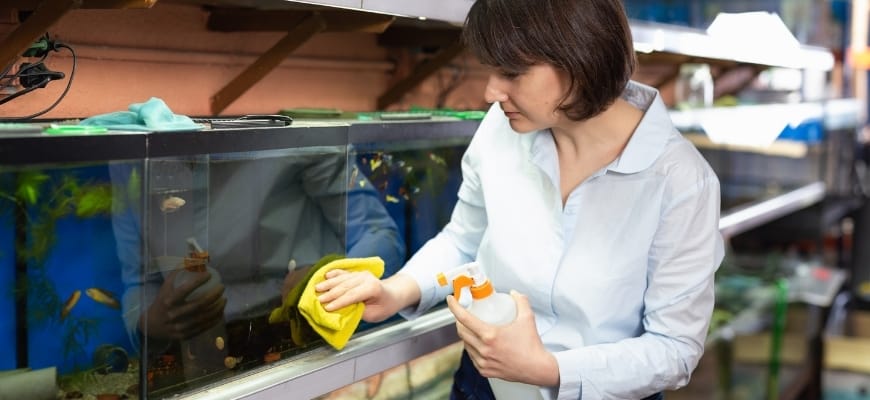
Before you leave for your vacation, you should clean your tank thoroughly. Use an aquarium vacuum to remove as much organic waste matter as possible, remembering to clean between plant bases, underneath decorations, in the tank corners, and under internal filter boxes.
At the same time, carry out a partial water change. There’s no need to go overboard, just refresh around 25% to 30% of the water. If you change too much water in one go, you risk stressing your betta and removing too much of the beneficial bacteria that are necessary for your biological filter system to work correctly.
You should also rinse the filter media through in some old tank water to remove any gunk that could obstruct the flow through the media. If your filter media is due to be replaced, it’s a good idea to do that. That way, you know that your betta’s tank is clean and safe for your pet before you head off on vacation.
Light ‘Em Up!
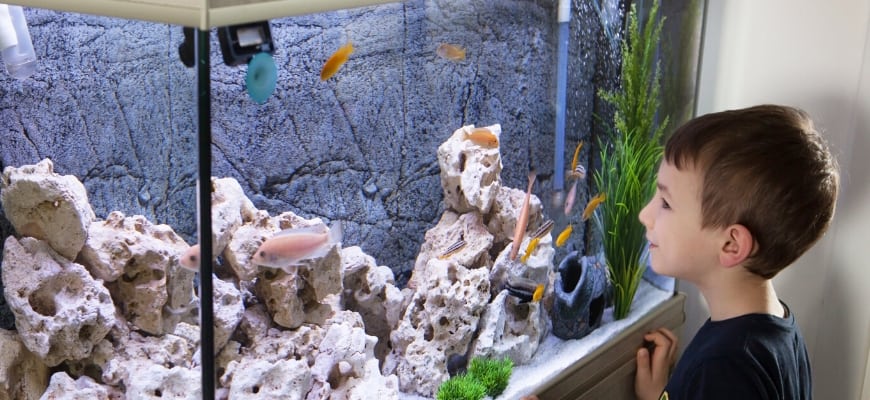
In the wild environment, bettas become active in the morning when the sun rises and insect activity begins. The fish learn that daylight means feeding time. At sunset, the fish retire for the night and become relatively inactive. Even though captive fish don’t necessarily need bright light to be happy, they do need that same day and night cycle to give their day some structure and routine.
If your betta fish doesn’t know whether it’s day or night, he may become stressed, which could lead to health problems. For that reason, you shouldn’t leave the lights off completely or switched on 24/7 while you’re away. Also, if the lights are on constantly, there’s a danger that your betta’s tank might overheat.
Live Plants
If you have live plants in your betta’s tank, they need light to photosynthesize. If the plants are starved of light, they will fail to grow and thrive and might even die while you’re not around to tend to them.
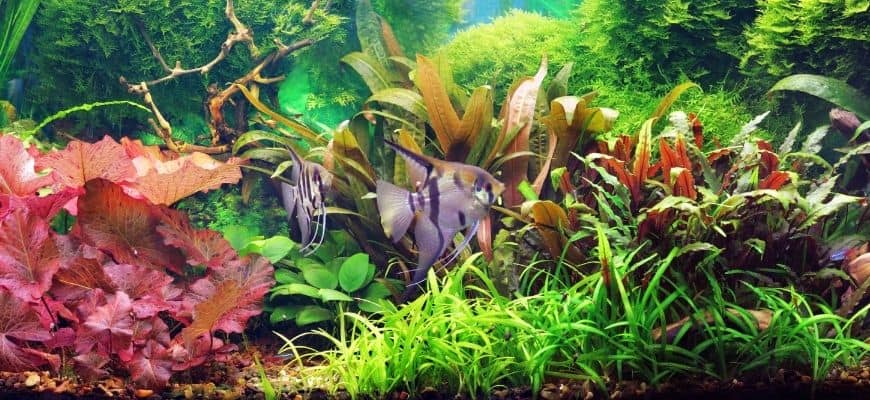
Also, living plants take up CO2 from the water and give off oxygen, helping to keep the water well-oxygenated for your betta. Live plants also use nitrates as fertilizer, keeping the environment pollution-free and supporting your tank’s biological filter. So, if your plants don’t get a minimum of eight hours of light every day, the health of the ecosystem in your tank will suffer.
Light Timers
The easiest way to manage the lights in your betta’s tank is by using a timer. Some modern LED lighting units come with an integrated timer that you just need to set when required. However, if your light unit doesn’t have a built-in timer, you can buy one.
That sounds like an expensive solution to your lighting dilemma, but it really isn’t. You can buy a simple timer from a hardware store for just a few dollars, and the peace of mind that gives you is well worth the modest expense.
All you have to do is set the timer to come on and go off when you want, via the simple dial on the unit. Plug your lighting unit into the timer and plug the timer into the mains power socket. Now, the unit will automatically come on and go off when you need it to, even though you’re not around to operate the system manually.
Natural Light
Iridescent Sharks are timid and rather shy, and their behaviors change as they mature. Juvenile sharks prefer to live in groups and often school together for safety, which is simply a beautiful sight. Once they reach adulthood they become a little less social and more independent.
As active and strong swimmers, sharks need a lot of open room in the middle of the tank, and they’ll also swim to the top or scavenge through your substrate looking for food. They’re usually easy-going, but they have an impressive startle response that can send them reeling into your tank or equipment, so always approach slowly.
Natural Light
Even if you can’t afford a timer, you can still use natural light to ensure that your pet has some form of lighting in his tank.
Don’t put your betta’s tank in direct sunlight, though! Direct sunlight encourages algae to grow and will also cause massive temperature fluctuations that could kill your betta.
Instead, you can put the tank in a room that’s fairly bright without being too sunny, if that makes sense.
Check Your Aquarium Equipment
As well as cleaning your betta’s aquarium and making arrangements for lighting, you should also give the other equipment a quick check to make sure that everything is working properly.
Heater
Bettas are a tropical species that cannot live in a tank without a heater unless you live in a region where the temperature is constant all year round. Ideally, you want a heater with a built-in thermostat that keeps the water temperature precisely the same 24/7/365. Bettas are very sensitive to fluctuations in water temperature, and changes can cause your pet considerable stress. In the absence of a thermostatic heater, be sure to invest in a good quality aquarium thermometer so that you can monitor the water temperature on a daily basis. If you choose a preset heater, make sure that the parameters are suitable for bettas.
Ideally, the temperature in your betta’s aquarium should be between 76° and 82°F. The most important thing is that the water temperature remains constant. Bettas can suffer from temperature shock if the water temperature fluctuates. That will stress your betta, potentially leading to health problems for your pet.
Also, your betta is a labyrinth breather, periodically coming up to the water surface to take gulps of air. The effective function of the labyrinth organ is crucial to your betta’s health since he cannot get all the oxygen he needs from the water alone. If the water temperature and ambient room temperature are wildly different, the betta’s labyrinth organ could be damaged.
Check The Filter And Pump
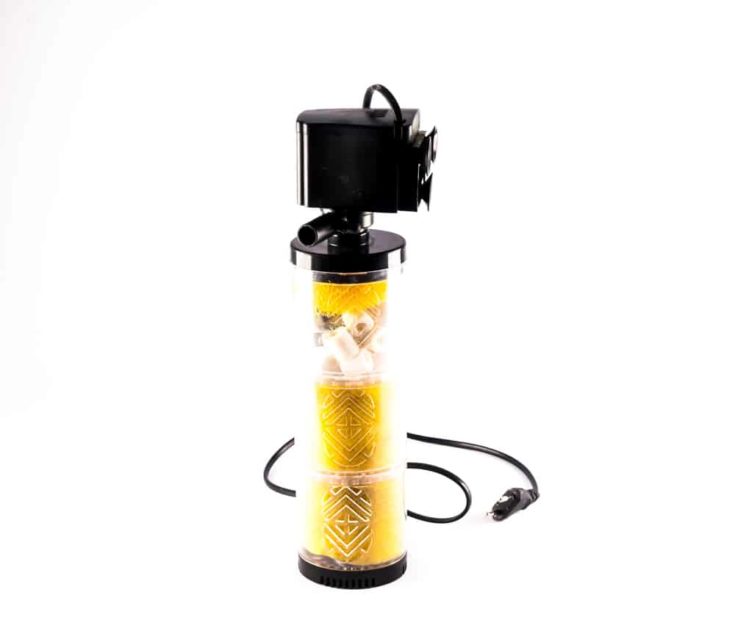
Your betta’s aquarium needs an efficient filtration system to keep the water clean and safe for your pet.
Once you’ve cleaned the filter system, you need to check that the pump is working correctly. If the pump or impeller are faulty, the unit won’t circulate the water through the tank properly, and the water will quickly become toxic for your betta.
If you have a drip loop, check that it’s correctly set so that there’s no danger of electrical shorting if there’s a power outage while you’re away.
Options To Consider When Organizing Fish Care While On Vacation
So, what are your options for fish care for your betta when you go away on vacation?
Ask A Friend Or Neighbor
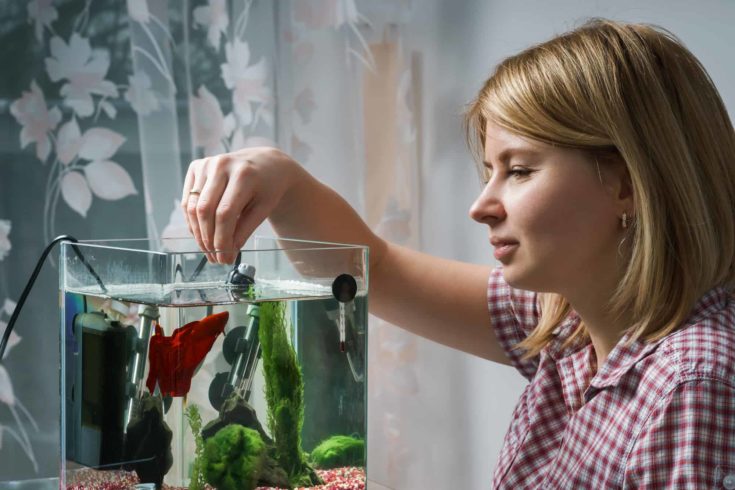
If you have a knowledgeable friend or neighbor that you’re on good terms with, you could ask them to take care of your betta while you’re away.
Essentially, you still need to carry out all the preparation work that we’ve described above, so that all that’s required is for someone to feed your fish once a day and check that the lights, filter, and heater are working.
Make sure that your “volunteer” doesn’t overfeed your betta and has your emergency contact number in case of anything untoward happening.
Leave Your Betta Unfed For A Couple Of Days
If you’re only going to be away for a weekend or you’re just going out of town for a couple of days, your betta should be fine if you leave him without food.
Mechanical Auto-Feeders
Mechanical auto-feeders can be used to feed your fish while you’re away or even if you work long hours and can’t always be there to give your pet his food.
How Do Auto-Feeders Work?
Auto-feeders work by holding the food in a small container and dispensing a measured portion of food at a preset time. The device rotates and releases the food when the allotted time arrives.
I recommend that you buy the best quality auto-feeder you can afford. Cheaper models often have issues, such as the accumulation of condensation inside the food container that makes the food damp, clogging the device so that the food isn’t released.
To be on the safe side, always have a test run and try out your feeder before you go away.
Best Mechanical Auto-Feeders
Here are a few of the best mechanical auto-feeders that are currently available on the market. These are all reliable devices that you can use, safely in the knowledge that your betta will receive his meals in the correct amount and at the correct time.
1. Eheim Everyday Feeder
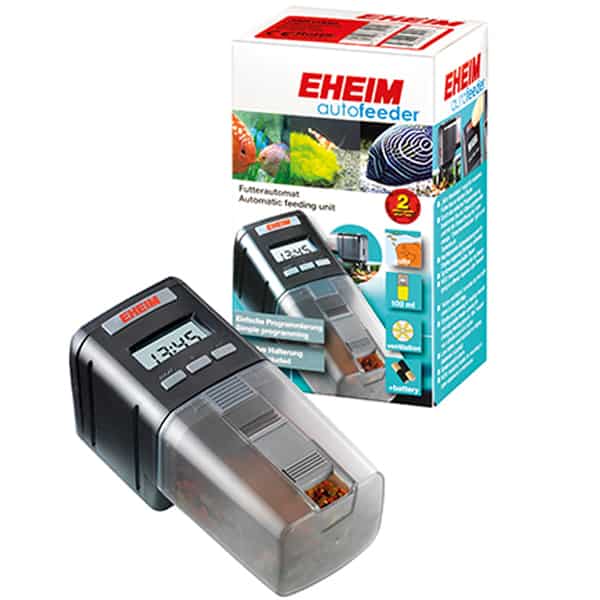
The feeder will fit a variety of different fish tank designs thanks to the universal installation clamp and is easy to set up.
If you’re looking for a reasonably-priced vacation feeder to solve your betta long-term food provision dilemma, the Eheim Everyday model is ideal. Eheim is a highly reputable manufacturer of many aquarium-related products, including filters.
The device is very easy to set up and use and reliably delivers your betta’s food exactly as you want. The food hopper can hold up to 100ml of fish food, meaning that one fill can easily last for six weeks, more than enough for your betta during your vacation. The food container is transparent, so you can easily see how much fish food is left.
PROS
- Simple to set up and use
- Very reliable
- Consistent delivery of food
CONS
- Only holds dry food
- Not moisture resistant
2. Barkmew Moisture-Proof Dispenser
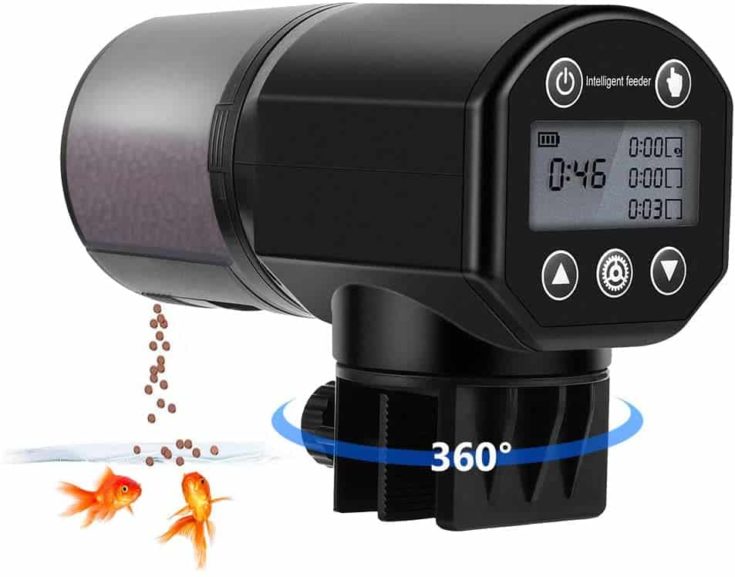
The unit is super-reliable, so you need never worry that your betta buddy will go hungry.
The Barkmew Automatic Fish Feeder is a mid-range device that’s a great choice for you if you have a reasonable budget at your disposal.
The feeder is very easy to set up and install. The generous 200ml food hopper is transparent so that you can see exactly how much food is left inside. Also, the unit is moisture-proof for safety and to ensure that your fish food doesn’t get damp.
PROS
- Simple to set up and use
- Super-reliable
- Moisture-proof
CONS
- Only holds dry food
- Not the cheapest product on the market
3. Fish Mate F14 Aquarium Feeder
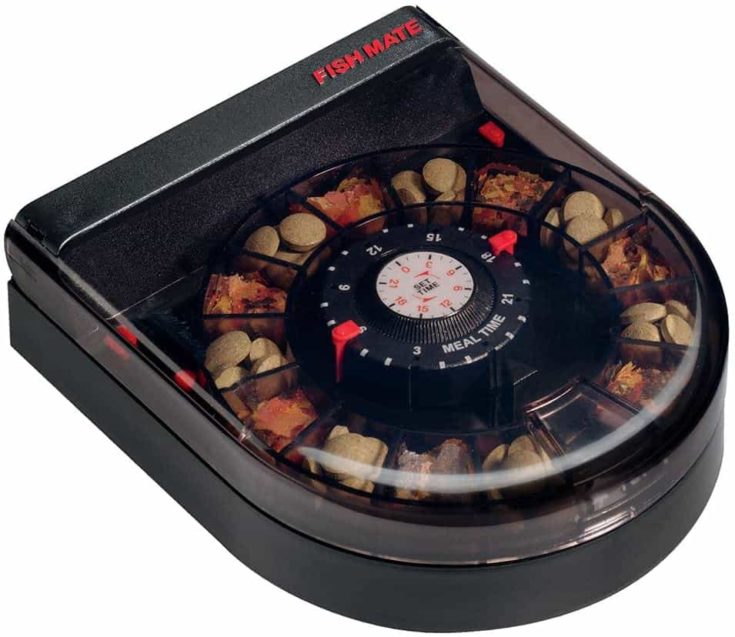
The Fish Mate F14 Aquarium Feeder is a handy little device that features 14 individual meal settings, so you can offer your betta a variety of foods while you are away on vacation.
You can mount the feeder on the tank hood, condensation tray, or on the edge of the tank, and all the fittings you need are included with the device. The accurate quartz timer ensures that the food is dispensed at preset times over a 14-day period, and you can set the feeder to provide up to four meals every day.
PROS
- Simple to set up and use
- Super-reliable
- Contains up to 14 days’ supply of food
CONS
- Only holds dry food
- Flake food tends to stick to the hopper
Block Feeders
Block feeders are used by some people to keep their fish fed while they’re away. You simply drop the blocks into your fish tank, where they gradually break down, releasing small amounts of food for your fish to pick at.
However, I don’t generally recommend block feeders, as these can be a very unreliable way of feeding your fish. Also, I’ve found that blocks tend to make the tank water very cloudy and can increase the levels of nitrates.
Find A Pet Store To Take Your Fish
If you have a good relationship with your local pet store and your betta has a small aquarium that’s easily transportable, you might find that the store will take care of your fish while you’re away.
However, if your pet has a large tank that can’t be transported, be careful of having the pet storehouse your fish in a small betta box. Often the stress of transportation and change of home makes bettas sick, so we don’t recommend that option.
Quick Betta Fish Vacation Feeding And Care Tips
- Clean your betta’s tank, maintain the filters, change filter media if necessary, and carry out a partial water change before you leave.
- Check that all the equipment in your fish tank is working properly and safely.
- Use an automatic fish-feeder to keep your fish fed correctly while you’re away.
- Ask a friend or neighbor to keep an eye on your pet while you’re on vacation.
- If you’re only away for a couple of days, consider fasting your betta.our fish fed correctly while you’re away.
In Conclusion
I hope you enjoyed our guide to caring for your betta fish while you’re away on vacation. If you did, please remember to share!
Before you go away, clean your betta’s tank, carry out a partial water change, and check that all your aquarium equipment is working correctly and safely. Invest in an automatic fish feeder to ensure that your fish doesn’t go hungry in your absence.; just,
Have a great vacation!